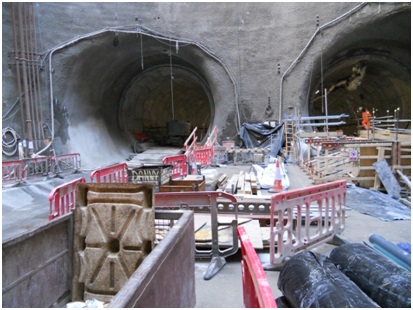Fostering win-win solutions through innovative partnerships for landscape engineering
Crossrail Tunnel portal at Canning Town tube station in E London
RSPB, 9 October 2015
Within the Wallasea Project, land-raising and landscape engineering was innovatively approached by creating a novel public private partnership. Materials from the Crossrail tunneling project were transported to a low-lying coastal area at high risk of flooding, in order to raise the land. The project thus established a precedent for using largely waste material generated by a major infrastructure project to meet biodiversity conservation and climate change adaptation aims elsewhere. Financing stemmed from both the private company Crossrail as well as from the Environment Agency, with all parties profiting due to the economic as well as environmental benefits set off by recycling the leftover materials. With Crossrail on board as a delivery partner, the project represents a partnership between Europe's largest civil engineering project and Europe's largest intertidal habitat creation project.
Instead of paying to remove waste materials from tunnel construction, Crossrail opted to transport them to Wallasea Island. An unloading facility enabled the materials to be shipped and then distributed across the island to build the habitats. Crossrail covered most costs (e.g. land purchase and some staff costs), with the Environment Agency (RA) funding the rest. The EA `bought` into the project to deliver replacement habitats for areas impacted/lost within the local Natura 200 network.
While sufficient buy-in was obtained by RSPB to buy the land, funds had not initially been collected to carry out the project itself. At this point, Crossrail came forward with an offer of materials and funding that permitted the project to move forward with more confidence. The main lesson learned is thus to think ‘outside the box’ and consider novel (public-private) partnerships to tap into previously unconsidered resources, and making sure to highlight the range of benefits which will be delivered to each party as a result of the project. Furthermore, a strong relationship with the landowner was particularly important in the early design phases of the project, as this led to the ability of RSPB to take out a two-year purchase option. This meant that, for a two-year period, RSPB could purchase the majority of the island if they decided to, and the price would be fixed at the beginning of this period, thereby creating some certainty surrounding the initial costs of the project.

